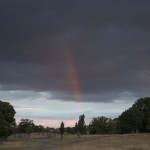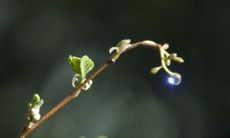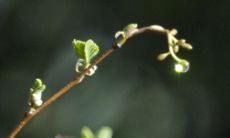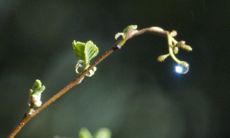I took this short sequence in the garden this afternoon. No photo-shopping, just a nice illustration of the splitting of sunlight into it’s component colors by refraction through a water drop – shuddering in the breeze after a storm.
 The simplest of things, it put me in mind of John Keats’s supposed lament that Isaac Newton had destroyed the beauty of the rainbow by explaining the science behind it, the underlying sentiment of which he included in the poem Lamia. I say supposed, because I can’t find a primary reference to Keats actually ‘having a go’ at Newton over his prism or whatever. Lamia however speaks for itself (see below).
The simplest of things, it put me in mind of John Keats’s supposed lament that Isaac Newton had destroyed the beauty of the rainbow by explaining the science behind it, the underlying sentiment of which he included in the poem Lamia. I say supposed, because I can’t find a primary reference to Keats actually ‘having a go’ at Newton over his prism or whatever. Lamia however speaks for itself (see below).
 Richard Dawkins gives an alternative view in his book, Unweaving the Rainbow, where he argues scientific understanding enhances rather than diminishes beauty. I’m with Dawkins on this one. And while those going through life without a scientific education (for whatever reason) experience it in a way that is different, I believe they are also simply missing out.
Richard Dawkins gives an alternative view in his book, Unweaving the Rainbow, where he argues scientific understanding enhances rather than diminishes beauty. I’m with Dawkins on this one. And while those going through life without a scientific education (for whatever reason) experience it in a way that is different, I believe they are also simply missing out.
Keats’s rainbow reference appears in his poem Lamia Part II:
What wreath for Lamia? What for Lycius?
What for the sage, old Apollonius?
Upon her aching forehead be there hung
The leaves of willow and of adder’s tongue;
And for the youth, quick, let us strip for him
The thyrsus, that his watching eyes may swim
Into forgetfulness; and, for the sage,
Let spear-grass and the spiteful thistle wage
War on his temples. Do not all charms fly At the mere touch of cold philosophy?
There was an awful rainbow once in heaven:
We know her woof, her texture; she is given
In the dull catalogue of common things.
Philosophy will clip an Angel’s wings,
Conquer all mysteries by rule and line,
Empty the haunted air, and gnomed mine—
Unweave a rainbow, as it erewhile made
The tender-person’d Lamia melt into a shade.




In regards to your Richard Dawkins comment, Richard Feynman also wrote a story somewhat similar about his artist friend and himself talking about the beauty of a flower.
Very cool.
Jarrid, yes – I now remember Feynman writing about that; I think he may even have referenced it in an interview. He was another person who got huge and visible pleasure from his understanding of science and technology.
Also, the example of Feynman clarifies my statement that people who don’t understand are missing out. I’m sure there were aspects of the world that he understood at a level I never will, and I’m comfortable admitting I’m missing out on the reward he got from that. Equally, I’m happy to admit I’m doubtless missing out on much good Chinese literature because I can’t read Chinese; but if I did understand it and enjoyed it, I would encourage others to learn. That’s where I’m at with science in this post – no more, no less.
If I were a better wordsmith, I’d rewrite that poem. The Lamia does not fade for me, the rainbow is still as lovely to my eye as an adult as it was to me as a credulous child who searched for fairies and had a special friend who lived under the bathroom sink.
I’m an artist, but I also have a background in zoology and botany. I spend a great deal of time around other artists, and not to be too stereotyping, most of them have no background in science and no interest in science. I sculpt a lot of animals and very occasionally I will be asked how I get them to look so alive and in motion. If I mention truthfully that I have been inside a few dozen animals and have learned how they work, other artists will look at me with utter disgust. Some of my artist friends also know I am a skeptic and they will occasionally talk about how I must be missing out with no spiritual component to my art.
They miss how much I enjoy feeling the curve of muscle as I fill in the clay – knowing the animal’s shoulder for my own, and the joy of fellow feeling and epiphany in knowing I am part of that sculpture in a certain special way. But for a few genes here and there, I am no different than the fox I made to top a pot – the vertebrae, the alignment of the skull, two eyes looking back. To claim that I am missing out is missing the point – science makes the connection to my art all the stronger and all the sweeter.
It makes me sad that I am afraid to make it very public that I am skeptical and an artist. So many of my customers subscribe to the supernatural that if I made it clear that my inspiration is my admiration for natural forms, evolution and physical motion, I may lose a good number of them. So, I am afraid to say anything, to explain that I love bones and not souls might render me bankrupt.
Karen, thank you very much for that. Not because we happen to agree, but because you explain so well how a material understanding of your subjects and their origins feeds into your art.
My wife Erin is a jewelry designer and silversmith with a background in mathematics, and geometric forms and an understanding of how mathematical relationships appear in nature often feeds into her design process. I’d even say she gets almost spiritual about it – while staying perfectly rational. Both of us paint at an amateur level and likewise find our non-artistic backgrounds feeding into that, not spoiling it.
As an animal sculptress you may like to check out the work of Loet Vanderveen: http://www.coastgalleries.com/vanderveen/index.cfm. He talks of the importance of studying the real animal to extract and freeze the essence of a characteristic movement. It’s also interesting to see what happens when artists reproduce animals without that kind of information – see my post on the Otaheite Dog: https://communicatescience.com/zoonomian/2008/11/30/roast-dog-and-aquatint/
And what a shame you feel the need to keep your inspiration under wraps. It sounds like some of your artist colleagues and customers are actively avoiding scientific understanding – like they’d get infected and be unable to function.
It would be really interesting to see someone who takes that view explain exactly how they feel. Any takers?